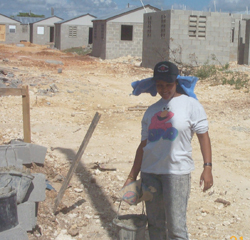You are here » Home » Telling Our Story
Case Study
A community makes a fresh start after a natural disaster
Rebuilding after Hurricane Georges

| |
Photo: USAID/Henry Welhouse
|
|
People residing in Padre Nuestro now live in a healthier environment and have access to running water and electricity.
Working together with local business and organizations, residents of Padre Nuestro have built a health center and community building, and received awards and recognition for eco-friendly development.
|
Challenge
In 1998, Hurricane Georges destroyed many homes and businesses in the Bayahibe area on the southeast coast of the Dominican Republic. A group of displaced residents decided to rebuild their homes close to a national park, Parque del Este. Using scrap material from destroyed hotels, they constructed new homes near an aquifer, a geological formation that filters groundwater. The location of the new houses created health hazards for residents and tourists, but it also posed a threat to the area’s delicate ecosystem and the aquifer. Also, without water and sewage infrastructure, the new settlement would likely contaminate the shoreline, the naturally filtered groundwater, and the beaches that attract vital tourism dollars to the region.
Initiative
USAID helped build 150 homes in a more sustainable location and encouraged people who lived above the aquifer to move there. Meanwhile, local and national partners built electrical, water, and sewage infrastructure there to ensure a healthy and sanitary environment. In addition, part of the land above the aquifer became an eco-tourism park that generated new jobs and that was incorporated into the Parque del Este, ensuring its protection for future generations.
Results
In just a few years, the new neighborhood, which named itself Padre Nuestro, had turned itself into a real community: with assistance from local businesses and organizations, residents built a health center as well as a community center that serves as both a primary school and vocational training site. Residents are taking responsibility for the development of their community and ensuring that their neighborhood is eco-friendly and environmentally responsible. In fact, the community has received environmental certifications for its work. Moreover, by working with local businesses, this small enclave have become a model of a productive community-business relationship. Together, they are an example for other communities that face similar situations in the future to follow.
Print-friendly version of this page (413kb - PDF)
Click here for high-res photo
Back to Top ^ | 

